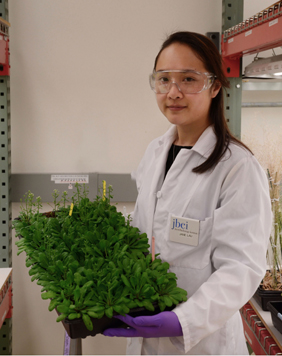Dec
4
A New Route to Engineer Plant Genes For Biofuels
December 4, 2012 | Leave a Comment
Plants high in lignin and hemicelluloses – lignocellulosic biomass – have a high content of pentose sugars (five carbon atoms) that are more difficult to ferment into fuels than plants with hexose (six carbon atoms) sugars. Also lignocellulosic biomass is naturally resistant toward deconstruction to sugars technologies due to the abundant and very tough lignin and cross-linked hemicelluloses.
The problem builds up because lignocellulosic biomass has a high content of those pentose sugars, which are more difficult to ferment into fuels than the hexose sugars.
So the LBNL team is engineering plants with decreased amounts of xylan in their secondary walls. This should raise the potential to render plant biomass as a more desirable feedstock for biofuel production. The goal is engineer plants with smaller amounts of xylan – the major non-cellulosic polysaccharide – present in secondary cell walls. The study has been published in BioMed Central’s open access journal Biotechnology for Biofuels.
To do the work the research group used 3 mutant strains of Arabidopsis that are deficient in xylan with irregular transport tissues, (irx) mutants irx7, irx8 and irx9. This allows engineering plants with low xylan content and improved properties for easier breakdown of carbohydrate into simple sugars (saccharification).

A Restored Transport Vessel Aribidopsis Sample. Image Credit: Yves Verhertbruggen. Click image for the largest view.
The group chose the irx mutants because they normally exhibit severe dwarf phenotypes that result from transport vessel collapse and thus impaired transport of water and nutrients. The team hypothesized that restoring xylan biosynthesis in the plants would complement and improve the mutations growth.
To reintroduce xylan biosynthesis into the transport vessels of irx7, 8 and 9, lead author Henrik Scheller and colleagues manipulated the promoter regions of vessel-specific VND6 and VND7 transcription factor genes. Significantly, they found that the ensuing phenotypes completely restored wild-type growth patterns in some cases, resulting in stronger plants with restored mechanical properties, while at the same time maintaining a low overall xylan content and improved saccharification properties that allowed for better breakdown into biofuels.
The results are impressive. The group obtained plants with up to a 23% reduction in xylose levels and an 18% reduction in lignin content with restoration of the transport vessel function. The plants also showed a 42% increase in saccharification yield after pretreatment. That is very impressive, indeed, and quite surprising.
Scheller said, “These results show that it is possible to obtain plants that have reduced amounts of xylan in their walls while still preserving the structural integrity of the xylem (transport) vessels. The xylan engineering system we present here is a great step towards tailored bioenergy crops that can be easily converted into biofuels. This approach in Arabidopsis has the potential to be transferred to other biofuel crop species in the near future, in particular, the poplar species.”
Arabidopsis is a very common and popular laboratory plant species. Often, but not always, its changes can transfer technologically into other species. It’s not a sure thing. Yet the results from the LBNL research group provides well founded hope that a viable alternative to fossil fuels may soon be available.

